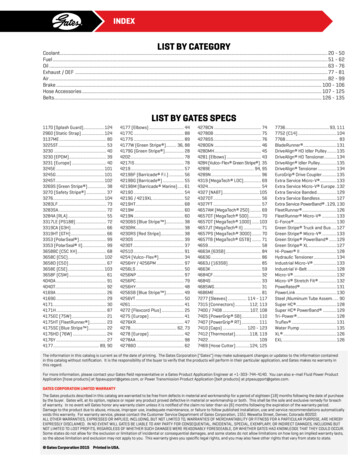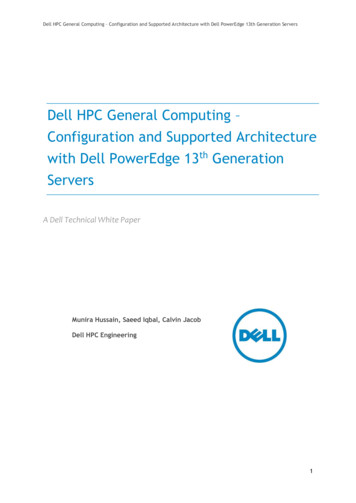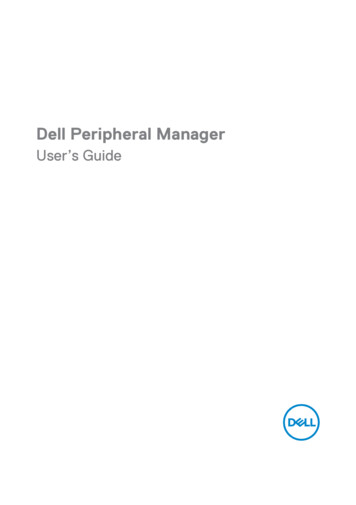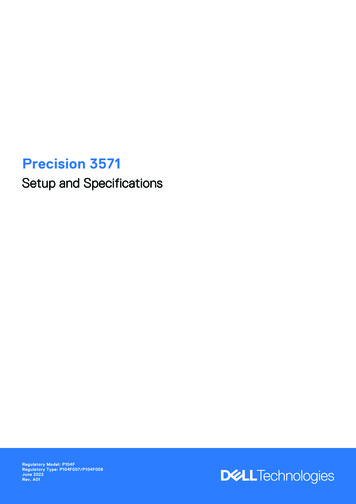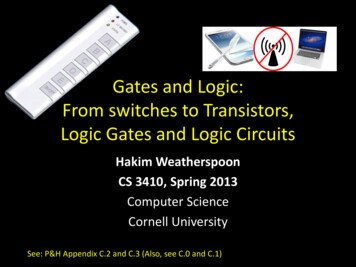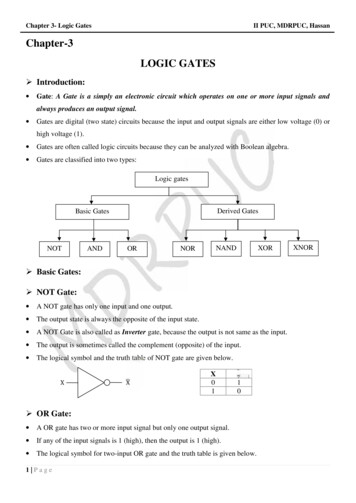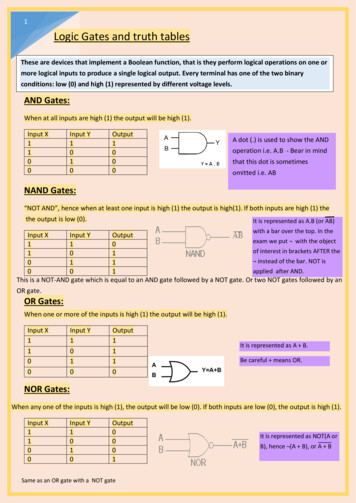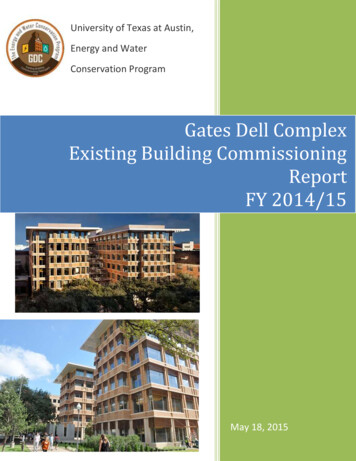
Transcription
University of Texas at Austin,Energy and WaterConservation ProgramGates Dell ComplexExisting Building CommissioningReportFY 2014/15May 18, 2015
Gates Dell Complex – Existing Building Commissioning Report – FY 2014/15Executive Letter from the Associate Director of UT Facilities Operations &MaintenanceThe University of Texas at Austin has a renewed commitment to an energy conscious campus. To fulfill thiscommitment we need to operate and behave in completely new ways, making energy conservation an integralpart of our day-to-day operations and activities.As Associate Director of UT Facilities Operations and Maintenance, my Energy & Water Conservation (EWC)team and I have worked diligently to poise ourselves to be the catalyst for this renewed commitment toenergy and water conservation. Our approach is simple: minimize our environmental impact,work collaboratively with the campus community,utilize technical tools and expertise to bring about positive changes, andshape new behaviors centered on making our campus energy efficient, while keeping in mind ouruniversity’s mission and the safety of the campus.Our long term goals present challenges that are substantial, multifaceted, and systemic. Put simply, our goalsdemand innovation, accountability, and a departure from “business as usual,” not only for campus, but for usas well.This report is an overview of the commissioning effort conducted at the Gates Dell Complex (GDC) building oncampus during August 2014 – April 2015. The building has been part of the UT landscape since 2012. Ofcourse, none of this could have happened without the support of GDC building management staff – PattiSpencer, Matt Larson, and Matt Walker – along with all the occupants at GDC and assistance from otherdivisions within Facilities Operations and Maintenance (Zone 1 and the Building Analysts Team). We thank youfor your continued support of our program and look forward to working with you in the future.Energy and water conservation is continuous, it takes small changes to make a big difference, and it all beginswith you. We welcome your suggestions, comments, and ideas to make a positive difference.Dan ClairmontAssociate Director, Facilities Operations & Maintenance1
Gates Dell Complex – Existing Building Commissioning Report – FY 2014/15OverviewThe University of Texas at Austin Energy and Water Conservation Program (EWC) is part of UT’s FacilitiesOperations and Maintenance division within the Facilities Services department. EWC’s mission is directed bythe President’s Sustainability Steering Committee to reduce demand side energy and water consumption foreducation and general buildings on campus by 20% by the year 2020 (baseline 2009).This document summarizes the Energy and Water Conservation Program’s commissioning of the Gates DellComplex (GDC) conducted August 2014 – April 2015 and includes the following: OverviewProcessResultsAHU and BAS Systemso New & Enhanced HVAC Building Automation System (BAS) Programming Terminal Level Improvements Expand Temperature Deadband Disable Sliders Dueling Boxes Adjust Minimum Space Air Volume Air Handler Unit (AHU) and Heating Hot Water Sequence Improvements AHU Supply Air Temperature Reset Optimum Start/Stop Economizer Continuous Commissioning Rogue Zone Diagnosticso Lightingo Plug Loads General Server Rooms Audio-Visual Equipment Computers and Printers in Labs and Offices Digital Signs Additional Topicso WaterFuture2
Gates Dell Complex – Existing Building Commissioning Report – FY 2014/15ProcessBelow are the steps that were undertaken for this commissioning effort.1. Review Building Historya. Review work order historyb. Analyze utility performancec. Design review2. Audit Building Systems3. Prioritize and Implement Energy ConservationMeasures4. Monitor Building5. Report Findings and Continued MonitoringReview Building HistoryAudit Building SystemsPrioritize and ImplementMonitor BuildingReport Findings and Continued MonitoringResultsSince this is a newer building, accurate utility data exists back through fiscal year 2014. As of the writing of thisreport, the latest utility data was used, which extends through February 2015. Implementation of energyconservation measures started during the month of October 2014. Therefore, current results include fourmonths of accurate data.In the four months since energy conservation measures began, GDC has seen an average utility reduction of 12,789.68 per month in comparison to the same calendar month in the previous fiscal year. Thusfar, thelargest monthly reduction from year to year is 18,678.99, occurring in February 2015, which is also the mostrecent month with released utility data. We are estimating that the annual cost avoidance will beapproximately 250,000 and the cost for out of house services was 15,000. The percent cost avoidanceduring the four month measurement period per utility is as follows: 46% avoidance of chilled water use6% avoidance of electrical energy use49% avoidance of steam use3
Gates Dell Complex – Existing Building Commissioning Report – FY 2014/15GDC Total Utility Cost 80,000.00Energy Conservation Measures Implemented 70,000.00 60,000.00 50,000.00 40,000.00 30,000.00 20,000.00 10,000.00 0.00SEPOCTNOVDECJANFEBFiscal Year 2013-2014MARAPRMAYJUNFiscal Year 2014-2015Through February 2015, the measured average daily energy cost avoidance was 825.40.Total energy consumption in kBTU before and after the start of re-commissioning4JULAUG
Gates Dell Complex – Existing Building Commissioning Report – FY 2014/15Actual energy consumption versus weather normalized predicted consumptionAHU and BAS SystemsNew & Enhanced HVAC Building Automation System (BAS) ProgrammingEWC worked with the university’s BAS analysts and the controls contractor to adjust existing programmingand add new program sequences to maximize building energy efficiency. All of the energy conservationmeasures were done utilizing the existing controls infrastructure.Terminal Level ImprovementsExpand temperature dead bandGDC was designed to maintain a temperature dead band of 70-74 degrees where the damper opens tointroduce more air if the room temp goes above 74 degrees, and the reheat valve opens if the roomtemperature goes below 70 degrees. We changed the temperature dead band values to 70-76 degrees inunder-utilized spaces, storage closets, and corridors where occupant comfort is less of a concern. The specificboxes that were adjusted can be found in Appendix A – Expanded Temperature Band.Disable slidersThe room thermostats in GDC have sliders so occupants can adjust the temperature dead band by twodegrees up or down. While this works well in individually zoned offices, large auditoriums, corridors, andunder-utilized spaces, unchecked slider adjustments can drive entire air handler unit (AHU) systems and waste5
Gates Dell Complex – Existing Building Commissioning Report – FY 2014/15significant energy. For example, we found an AHU operating at its maximum static pressure set point and anunnecessarily high fan speed to try to cool a single telecom room down to 70 degrees. Once we disabled theslider at a cooling set point of 75, the damper closed off and the AHU fan slowed down. For our operationalrecord, Appendix B - Enabled Sliders shows the variable air volume (VAV) boxes where we left the sliderenabled for individual adjustment. All others are disabled.Dueling boxesSeveral of the larger teaching auditoriums and computer labs have two or more variable air volume (VAV)boxes serving a single space. In many cases the boxes are battling each other (i.e., one is in cooling and theother is reheating). To solve this problem we programmed a single temperature dead band set point for theroom (i.e., 71-75 degrees) and averaged the temperature sensors so that the boxes are responding in unison.Adjust Minimum Space-Air VolumeWe found several rooms were receiving more air than required by the American Society of Heating,Refrigerating, and Air-Conditioning Engineers (ASHRAE) ventilation standards and by the heat load in thespace. VAV boxes serving these rooms were using reheat to warm up the large volumes of air even during thehottest periods of the summer. A list of rooms where we decreased the minimum air flow rates to bettermatch the needs of the space are in Appendix C – Adjusted Minimum and Maximum Air Flow Rates.AHU and Heating Hot Water Sequence ImprovementsAHU Supply Air Temperature ResetThe original supply temperature reset sequence provided by the design engineer reset the supply airtemperature upwards as outside air temperature decreases. Since there are outside air pretreatment unitsaddressing the majority of the latent load and there is zone-level feedback, we adjusted the sequence to bemore aggressive. The new sequence allows the supply air temperature to reset all the way up to 65 degrees aslong as all spaces are less than 76 degrees and return air humidity is under 55%. Significantly less chilled waterand reheat hot water are being used due to this change in programming.6
Supply Air Temp Set Point (OF)Gates Dell Complex – Existing Building Commissioning Report – FY 2014/15Month/DayAHU-3 supply air temperature set point operates at 65 degrees most of the time after the improved supply air reset was programmed and tuned.The period of time where the supply air temperature set point was bouncing was due to a coffee shop where temperatures frequently go above 76degrees. We removed the coffee shop terminal box feedback from the supply air temperature reset programming so it would no longer drive thereset, and the system started maintaining 65 degrees on most occasions.Optimum Start/StopOptimum start/stop is a method that turns AHUs off during unoccupied periods and lets the BAS monitorconditions so that the units come back on at appropriate times. The BAS “learns” the amount of time it takesfor the building to return to desired room set point temperatures, depending on outdoor and indoorconditions. This allows the system to safely turn off but still respond to extreme conditions overnight andmeet comfortable conditions before the occupants arrive in the morning.EconomizerAn economizer sequence takes advantage of conditions where outside air is cool and dry and can be used forfree cooling. Similar to other buildings at the university with pretreatment units, the economizer mode will beon when discharge temperature of the outside air unit is below the discharge air temperature of individual airunits and when outside air temperature is between preheat and cooling set points (i.e., 50 and 55 degrees).The sequences of operation language for all of the ECMs mentioned above can be found in Appendix D – GDCEnhanced Sequences of Operation.7
Gates Dell Complex – Existing Building Commissioning Report – FY 2014/15Continuous CommissioningRogue Zone DiagnosticsTo help facilitate building maintenance and keep a high level of energy efficiency moving forward, rogue zonediagnostics were implemented to identify VAV boxes which are exhibiting symptoms of failure. The causes ofthese failures are varied, and may include: Improper thermostat placement (e.g., next to a heat source) Leaking valves Failed valve actuators Failed damper actuators Failed sensorsThe criteria we are using in the BAS to flag rogue zones are listed below: Reheat valve is open above 80% for more than 2 hours and the outside air temperature (OAT) is above40 degreesSpace temperature is less than 1.5 degrees below the heating set point for more than 2 hours and theoutside air temperature is above 40 degrees during terminal box occupied hoursSpace temperature is greater than 1.5 degrees above the cooling set point for more than 2 hoursduring terminal box occupied hoursDamper position is above 95% for more than 2 hours and the outside air temperature is below 100degreesLightingThe majority of lighting in GDC is controlled by the Square D Powerlink system and rooms such as classroomsand meeting rooms are controlled by the Crestron system. Private areas of the building, such as offices andrestrooms are generally controlled through a combination of light switches and occupancy sensors. For thepurposes of this audit, the Square D system was evaluated to determine how best to optimize the lightingcontrols in common areas, mechanical/electrical rooms, and storage rooms.To evaluate the current lighting system, maps of the building were created to define each lighting circuit, itsschedule, and the locations of override switches. After consulting with building occupants on various needs,the following changes were made to the Square D system: Input switch schedules were matched to the schedule of the zone it controls. This allows for manualON/OFF control of lights in common areas when the lighting schedule is OFF. The existing overrideschedule was removed from the programming.8
Gates Dell Complex – Existing Building Commissioning Report – FY 2014/15 Timers of 30 minutes to 2 hours were added to input switches to automatically turn off lights after aspecified time period. Previously, the lights remained on indefinitely when the input switches wereused.An office schedule was created for the north and south side 2nd floor offices that shortened weekdaylighting schedules and keeps lights off on weekends unless the input switches are used.Storage rooms on the south side first floor were taken off of schedules to be manually operated byinput switches.All atrium floors were matched to the same interior schedule.It should be noted that circuits in GDC often have override zones that allow for modification of specific circuitswithout affecting other circuits within the same zone. This can allow for temporary schedule changes that donot involve more complex programming. However, we recommend that more permanent schedule changesshould not use the override zone to avoid confusion.Lastly, it was noted that daylight harvesting was not includedin the central atrium and this area is often brightly lit withnatural light. A future project could be to investigate thistechnology to allow for light dimming.Detailed lighting maps (Appendix E) and current schedules(Appendix F) are located at the end of the report and will bedistributed to the building management and zonemaintenance.Plug LoadsGeneralAn inventory of all equipment (desktops, laptops, printers, AV equipment) is kept by the building managementteam. All equipment purchases must go through this department.Server RoomsThere are three server rooms inside the building with a total of seven servers. Each server room has its owncooling unit. EWC recommends these rooms to be evaluated to adjust to a higher temperature set pointwhere feasible.Audio-Visual EquipmentA/V equipment consists of plasma televisions, projectors and document cameras. The current A/V powermanagement procedure is when a lecture or meeting concludes, the user logs off. Logging off signals theequipment to shut down. When the building closes at midnight, building operators (paid interns) areresponsible for logging off and shutting down any A/V equipment that is left on.9
Gates Dell Complex – Existing Building Commissioning Report – FY 2014/15Although the A/V power management policy requires the user to log off after a lecture or meeting, thispractice is hard to enforce. So, it is common for users to not log off after a lecture or meeting concludes.Thereby, the A/V equipment is potentially left on all day and evening until the building operators check on therooms to turn off everything at midnight.Since most of the rooms with A/V equipment do not have occupancy sensors, the capability of tying the shutdown function on the A/V equipment is limited. EWC has given Computer Sciences a “Log Off” image so theycan load it on their computer as a reminder to log off after a meeting or lecture.Computers and Printers in Labs and OfficesThere are approximately 400 machines that are managed by the IT staff. Roughly half are desktops and theother half are laptops. The staff averages 3-4 desktops and 1.5-2 laptops per person. Current policy for users isto log out when the computer is not in use. After 15 minutes of no activity, the computers and monitors willgo into sleep mode, per the default settings. The monitor’s default setting is a black screen with no screensavers. Power management for computers can also be remotely controlled.The IT retirement policy for computers is approximately every four years. There is currently no policy to lookfor more efficient machines when purchasing new equipment. EWC recommends to purchase computers thatare ENERGY STAR certified. More information can be found oducts/detail/computersThe majority of the printers in the building are network printers; very few are individual printers. All printersare set-up to go into manufacturer’s energy saver mode settings.Digital SignsThere are 21 digital signs that are centrally managed. Current practice is for the digital signs to stay on 24/7because there are a number of events that occur over the year and there are occupants in the buildings afterhours. Presently, Computer Sciences staff are evaluating the energy reduction of turning off 10 digital signs inthe two main offices on the second floor. A kWh sample from the 10 digital signs will be taken using wattmeters. This data will be used to determine how to move forward.Also, since only computer science majors are allowed after the building closes to the public, EWC suggests toturn off all other non-essential signs between the hours of midnight to 6am since the only personnel enteringand leaving the building are already familiar with information displayed on these signs.Additional TopicsGDC Staff asked about energy savings or power benefits regarding virtualized servers vs. having informationstored locally. EWC will have to conduct further research on this topic and share their findings.10
Gates Dell Complex – Existing Building Commissioning Report – FY 2014/15WaterEWC conducted an audit of all the bathroom lavatory faucets, showerheads, and toilet and urinal flush valves.All lavatory faucets are manually operated. Each one was tested by using a measuring cup and stop watch.The subsequent flow was calculated to determine if it did not exceed the Campus Standard of 0.5 gpm. Allfaucets passed the test.Using the same test as the lavatory faucets, showerheads were checked and found to have a flow notexceeding 1.5 gpm. The Campus Standard is 2.0 gpm.Toilet and urinal flush valves are manually operated. Each flush valve was tested by recording the amount oftime the valve was open. The subsequent gpf was then calculated based on flow rates and valve time open.All but 5 (out of 94 total flush valves) were within tolerable range of the Campus Standard of 1.28 gpf fortoilets and 0.5 gpf for urinals. A work order was submitted to correct the 5 deficient valves.FutureTo continue optimizing this building, the relationship between EWC and the occupants, with support fromzone staff and analysts, will continue. Specifically, the Energy Steward assigned to GDC will continue therelationship with the building management staff and occupants and monitor building performance.11
Gates Dell Complex – Existing Building Commissioning Report – FY 2014/15Appendix A: Extended Temperature BandDate created:SR Number:VAV box audit group:BAS Identifier9/25/2014SR569413Expand temperature bandVAVH01.VAV1.2141-1-8H01.VAV1.702 1H01.VAV1.702 2H01.VAV1.728 1H01.VAV1.728 01.VAV1.902H01.VAV1.912H02.VAV2.600H02.VAV2.200 1H02.VAV2.200 7-38-7-149-7-49-7-5Building Analysts ItemDisable room thermostat slider. Expand dead band (Cooling Set point 76;Heating Set point 70)Same as aboveSame as aboveSame as aboveSame as aboveSame as aboveSame as aboveSame as aboveSame as aboveSame as aboveSame as aboveSame as aboveSame as aboveSame as aboveSame as aboveSame as aboveSame as aboveSame as aboveSame as aboveSame as aboveSame as aboveSame as aboveSame as aboveSame as aboveSame as aboveSame as aboveSame as aboveSame as aboveSame as aboveSame as aboveSame as above12
Gates Dell Complex – Existing Building Commissioning Report – FY 2014/15Appendix B: Enabled SlidersVAV Box 15H05.VAV5.5122-5-26H07.VAV7.8188-7-16Room Name & NumberTECH OF. 1.404, TECH OFF. 1.406TECH OFF. 1.408, TECH OFF. 1.412, TECH OFF. 1.414, CORRIDOR 1.400DEPT. CHAIR 2.308ACHAIR SUPPORT 2.308, MEETING 2.306ADMIN. VISITOR 2.314, ASSIST. DIR. ADMIN. 2.312ACCOUNT. OFF. 2.316, ACCOUNT. OFF. 2.318, ACCOUNTING OFFICE 2.320ASSOC. CHAIR OPS. 2.322ASSIST. DIRECTOR 2.726, ASSIST. DIRECTOR 2.724FOCS OFFICE 2.822, ADMIN NEW HIRE 2.820, PUBLICATIONS 2.814FACULTY OFFICE 3.502GRAD. OFFICE 3.504FAC. OFFICE 4.418, FAC. OFFICE 4.420, FACULTY OFFICE 4.422FAC. OFFICE 4.430, FAC. OFFICE 3.432, FACULTY OFFICE 4.436FACULTY OFFICE 4.806, FACULTY OFFICE 4.808FACULTY OFFICE 5.512, GRAD. LOUNGE 5.514FACULTY OFFICE 7.818Note: Thermostat sliders in all other rooms have been disabled.13
Gates Dell Complex – Existing Building Commissioning Report – FY 2014/15Appendix C: Adjusted Minimum and Maximum Airflow RatesBAS VAVIdentifier1.2101.310 11.310 21.4021.4121.702 11.702 21.7261.728 11.728 21.712 11.712 21.7261.9022.1042.2102.2122.216 12.216 22.216 32.216 42.216A2.4102.7122.7182.8142.8042.7243.436 13.5103.5123.414B3.414A3.7043.7263.8044.302 -3-79-3-141-4-19ScheduledMin 37021021049058014Original BASMin 5385210210490580New BASMin 0175175400500
Gates Dell Complex – Existing Building Commissioning Report – FY 2014/154.302 26.2026.302 0120200300400200200Note: Grey highlighted VAV boxes had BAS air flow minimums that were different from the scheduled air flowminimums (10/20/2014 As-Built Correction set). Correcting the minimum air flow rate in the BAS improvedsystem efficiency and/or comfort in the space. All others were adjustments from the scheduled minimum airflow rates to improved rates that better met actual space requirements.15
Gates Dell Complex – Existing Building Commissioning Report – FY 2014/15Appendix D: GDC Enhanced Sequences of OperationStatic Pressure Reset for OAHU-1 & 2The control system shall reset outside air handling unit static pressure set points (adjustable) from their lowestto their highest value as the most open damper of the AHUs associated with the OAHU goes from 65% to 95%open (adjustable) with a linear relationship in between. Include a graphic showing the linear fit table on theassociated OAHU page.Supply Air Temperature Reset at AHU-1, 2, 3, 8, & 9The chilled water valve should modulate to maintain the cooling air discharge temperature set point. Thecooling discharge set point shall reset from 55 degrees to 65 degrees, based on the temperature of the VAVsassociated with the AHU and the return air relative humidity (RH) at each AHU. If the maximum spacetemperature is equal to or less than 76 degrees, and the return air RH is equal to or less than 55%, thenincrease cooling by 1 degree to a maximum of 65 degrees. If the maximum space temperature is greater than76 degrees, or the return air RH is greater than 55%, then decrease cooling by 1 degree to a minimum of 55degrees. All values are adjustable.The following VAV boxes should be excluded from the supply air temperature V3.822VAV4.822VAV5.822VAV6.822VAV1.902Stop/Start for AHU 8 & 9 and OAHU 2 (to be repeated on AHU 1, 2, 3 and OAU 1 at a later date)Unoccupied Schedules: AHU 8 Unoccupied Schedule: 2:00 AM - 6:00 AM AHU 9 Unoccupied Schedule: 2:00 AM - 6:00 AM OAHU 2/ EXF 2 Unoccupied Schedule: 2:00 AM - 6:00 AM16
Gates Dell Complex – Existing Building Commissioning Report – FY 2014/15During the AHU Unoccupied Schedules the air handing units will shut down. The space temperatures for theVAV boxes listed below shall be monitored. If the space temperature for any monitored VAV Box goes above82F (adjustable) or below 63F (adjustable) for 30 minutes (using a sample rate of every 15 minutes), theassociated air handing unit shall start immediately.The outside air handling unit and exhaust fan will stop/start on the fixed schedule above (i.e., they will notstart early if the AHU starts early).Include a graphic showing which VAV box last went outside of the unoccupied temperature range during theunoccupied hours. Also include a graphic that lists the time at which all monitored VAV boxes reach theoccupied cooling or heating set A8-6-198-7-10VAV1.712 1VAV1.712 VAV7.812VAV7.81617
Gates Dell Complex – Existing Building Commissioning Report – FY 2014/15Economizer Sequence for AHU-1, 2, 3, 8, & 9When in economizer mode, incrementally increase outside air flow to its maximum value to maintain a mixedair temperature set point prior to air entering the chilled water coil. The mixed air temperature set pointshould be two degrees lower than the coil discharge set point. Otherwise, incrementally decrease outside airflow down to a minimum dictated by CO2 levels.Economizer mode ON if ALL of the following are true: Outside air unit cooling and preheat valves are closedDischarge temperature of the outside air unit is below the discharge air temperature of the individualair unit18
Gates Dell Complex – Existing Building Commissioning Report – FY 2014/15Appendix E: Lighting Map19
Gates Dell Complex – Existing Building Commissioning Report – FY 2014/1520
Gates Dell Complex – Existing Building Commissioning Report – FY 2014/1521
Gates Dell Complex – Existing Building Commissioning Report – FY 2014/1522
Gates Dell Complex – Existing Building Commissioning Report – FY 2014/1523
Gates Dell Complex – Existing Building Commissioning Report – FY 2014/1524
Gates Dell Complex – Existing Building Commissioning Report – FY 2014/1525
Gates Dell Complex – Existing Building Commissioning Report – FY 2014/15Appendix F: Lighting SchedulesFloor 1-1HLCircuit #13579111315Circuit #246810121416182022Input1234567816404748Circuit UseLightingLighting----NE&E Courtyard LNE&E Courtyard L----Circuit UseHallway--Classroom 1.304--Main Elect Rm--Em Elect Rm--Mech Room-----Zone #99----1010----Zone #1--9--8--6--7-----Zone NameSchedule #24hr ON24hr ON24hr ON24hr ON--------Exterior Zone2Exterior Zone2--------Zone NameSchedule #1st Flr Hallway1----24hr ON24hr ON----1 N Main Elec Rm------1 N EM Elect Rm------1 N Mech Rm-----------Schedule Name24hr ON24hr ON----Dusk to DawnDusk to Dawn----Schedule NameInterior Sched--24hr ON-----------------NameInput Type1st Flr N HallsMomentary Toggle1 N EM Elec RMMomentary Toggle1 N Mech RmMomentary Toggle1N Main Elect RMMomentary Toggle2nd Flr N HallsMomentary Toggle3rd Flr N HallsMomentary Toggle3rd Flr NW HallsMomentary Toggle4th Flr N HallsMomentary Toggle24hr ON OVRMaintained Normally ClosedFlr 1 N OverrideExterior Lts OvrExterior Lts OvrON Time24hr ON24hr ON----Sunset -30Sunset -30----ON Time7:00 AM--24hr ON-----------------Timer TypeTimed ONTimed ONTimed ONTimed ONTimed ONTimed ONTimed ONTimed ONNONENONENONENONEOFF Time24hr ON24hr ON----Sunrise 30Sunrise 30----OFF Time3:00 AM--24hr T,W,Th,F,S--Su,M,T,W,Th,F,S-----------------Timer 2:00:002:00:000:00:00Blink TypeNo BlinkNo Blink----No BlinkNo Blink----Blink TypeNo Blink--No Blink--Single Blink--Single Blink--Single Blink-----Override ZoneInputs--16 (24hr ON OVR)--16 (24hr ON OVR)--------47 (Exterior Lts Ovr)--48 (Exterior Lts Ovr)----------Override ZoneInputs40 (Flr 1 N Override)1 (1st Flr N Halls)------16
Gates Dell Complex - Existing Building Commissioning Report - FY 2014/15 8 Continuous Commissioning Rogue Zone Diagnostics To help facilitate building maintenance and keep a high level of energy efficiency moving forward, rogue zone diagnostics were implemented to identify VAV boxes which are exhibiting symptoms of failure. The causes of

